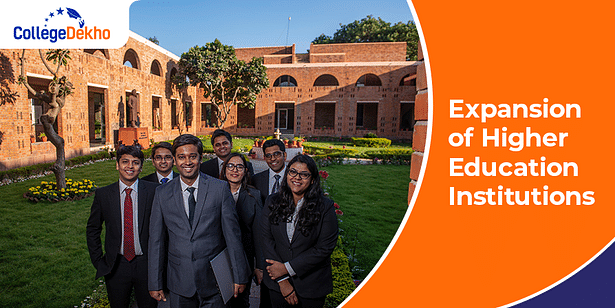
India has the world’s 2nd largest higher education network with more than 54K colleges. As per data available at the Ministry of Education of India in March 2024, there are about 43.3 million students registered for higher education in India, a growth of 2 million students as compared to 2023. Naturally, with an increase in the number of students seeking higher education today, there has been a surge in the number of higher education institutions in the country. According to NEP 2020, the government has given the nod to create top grade national level institutions and arm the state governments with enough ammunition to establish quality higher education institutes within the states catering to the increasing demand for skilled graduates, the need to bridge the Gross Enrollment Ratio (GER) gap, thereby promoting economic growth and regional development in those states.
Also Read:
CollegeDekho Launches India’s First Higher Education Trends Report - 'HEART'
While the government’s target of achieving a 32% GER by 2022 has not been met yet, it's exhilarating to see an upward trend.
Here is a quick look at the current GER in India:
Total Higher Education Institutions | 54,000+ |
|---|---|
Total Student Enrolment % | 28.3% |
Student Enrollment | 4.33 million |
Gross Enrolment Ratio % Increase (GER) (2022-23 vs 2021-22) | 0.7% (increase) |
Male vs Female GER% | 27.9% vs 29.1% |
Top Contributing States | Kerala, New Delhi, Chandigarh, Tamil Nadu, Haryana, Uttar Pradesh |
Top undergraduate streams | Arts (34%), Science (15%), Commerce (13%), Engineering & Technology (12%) |
Top post-graduate streams | Social Science (21%), Science (15%), Management (14%), Engineering & Technology (12%) |
Top Ph.D subjects |
Engineering & Technology (25%), Science (21%), Social Science (13%)
*Data sourced from AISHE Report 2022-23
|
| Changing Market Trends in Higher Education in India | Challenges and Trends in Higher Education |
|---|---|
| Recent Trends in Higher Education in India | Role of CollegeDekho in Higher Education |
So why is expansion of higher education institutes in India necessary?
Despite measures undertaken by the government, India still lags behind global benchmarks like China (GER at 51%) and developed nations like the United States and Canada exceeding 80%. To bridge this gap, the National Education Policy (NEP) 2020 has set an ambitious target of achieving a 50% GER by 2035. Other factors include:
- To meet India’s demand for educating the growing youth population
- With approx. 600 million youth under age 25, the education system has to keep pace with the growing needs of students
- Rising aspirations of families
- Increasing demand for skilled professionals across sectors
- Drive economic growth & development by contributing to the workforce, foster innovation & entrepreneurship, which can attract investment & create job opportunities
Top States with Maximum HEI’s in India:
State | No of HEI’s | Total Streams Available |
|---|---|---|
Uttar Pradesh | 1043 | 42,343 |
Maharashtra | 1034 | 41,345 |
Tamil Nadu | 1024 | 40,345 |
Karnataka | 1014 | 39345 |
Andhra Pradesh | 1004 | 38,345 |
Telangana | 994 | 37,345 |
Gujarat | 984 | 36,345 |
Madhya Pradesh | 974 | 35,345 |
West Bengal | 964 | 34,345 |
Bihar | 954 | 33,345 |
Related Links:
Importance of Right Counseling and Guidance
Given the ever-expanding educational landscape, the need for the right counselling and guidance for students becomes paramount. With a wider range of institutions and courses available, effective counselling can have a significant positive impact on students' lives. Here’s how:
- Make Informed Decisions: Counselling can highlight students' strengths, weaknesses, interests and skillset. If someone can help them identify them and make them self-aware, they will be able to make informed decisions about their future.
- Reduce Stress & Anxiety: Rather than running from pillar to post to choose and get admission to the right college, counsellors can reduce the students' stress by guiding them through and through & help navigate the application & admission process.
- Better Performance at Academics: Students who choose a course most suitable to their calibre & interest leads to increased motivation, better academic performance & high graduation rates.
The expansion of higher education institutions in India is a positive step towards achieving educational equity and national development. With a healthy mix of focus on quality with quantity, India will truly reap the benefits of a skilled and educated workforce.
Governments, educational institutions, and stakeholders must collaborate to ensure that the newly established institutions are well-equipped with qualified faculty, updated curriculum, and adequate infrastructure & at the same time, career counsellors should look at students’ capabilities and direct them to colleges & courses where they will prove their mettle and contribute to society.
















Similar Articles
Top Professional Courses in India after 12th and Graduation
List of Colleges in Delhi University: Affiliated/ Recognised Colleges in DU
How to Check IGNOU Assignment Status Online?
ITI Courses After 10th in India: Admission Process, Types, Fees, Career Options
List of Animation Courses After 12th: Popular Courses, Eligibility, Scope, Jobs & Salary
Top Delhi University Colleges 2025: NIRF Ranking & Score